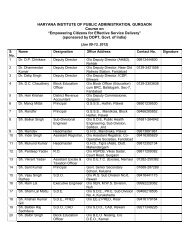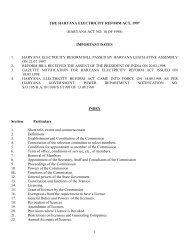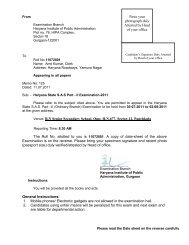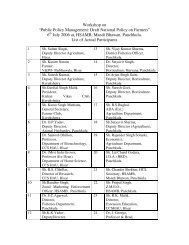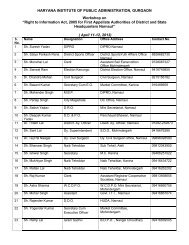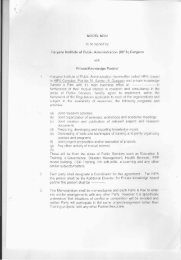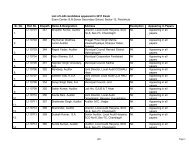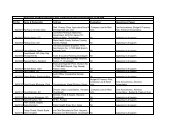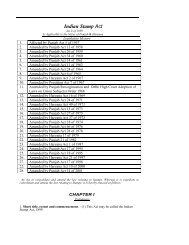Gurgaon Workshop Proceeding on Ist Dec. - HIPA
Gurgaon Workshop Proceeding on Ist Dec. - HIPA
Gurgaon Workshop Proceeding on Ist Dec. - HIPA
You also want an ePaper? Increase the reach of your titles
YUMPU automatically turns print PDFs into web optimized ePapers that Google loves.
In collaborati<strong>on</strong> withCore Group, <strong>HIPA</strong>, <str<strong>on</strong>g>Gurga<strong>on</strong></str<strong>on</strong>g><str<strong>on</strong>g>Proceeding</str<strong>on</strong>g>s of 1 <strong>Dec</strong>ember 2006 CIGReview MeetingC<strong>on</strong>tentsA. Sessi<strong>on</strong> I Opening Remarks1. Welcome Address2. Presentati<strong>on</strong> by Core Incubating Group Host Institute3. Remarks by Chairpers<strong>on</strong>B. Sessi<strong>on</strong> II Update and Comments by ATIs1. RCVPN AAM, Bhopal2. YASHADA, Pune3. ATI, Kolkatta4. AIM, ChennaiC. Sessi<strong>on</strong> III CBPR Experience sharing with UPAAM, LucknowD. Sessi<strong>on</strong> IV CIG Members Discussi<strong>on</strong>E. Summing UpAnnexuresI. Schedule of the CIG MeetingII. List of Actual ParticipantsIII. CBPR Update C<strong>on</strong>sisting Sh. S. Venkatesan’s Suggesti<strong>on</strong>sIV. CIG Discussi<strong>on</strong> NoteV. CIG Host Institute (<strong>HIPA</strong>) Presentati<strong>on</strong>VI. Presentati<strong>on</strong> made by YASHADAVII. Presentati<strong>on</strong> from ATI West BengalVIII. Presentati<strong>on</strong> by UP Academy (Leena Johri)IX. List of DoPT Master CDs available at <strong>HIPA</strong>X. Strengthening the State ATIs2
Core Incubating Group (CIG)Meeting <str<strong>on</strong>g>Proceeding</str<strong>on</strong>g>s 1 st <strong>Dec</strong>ember 2006The first formal review meeting was c<strong>on</strong>vened by the Core Incubating Group (CIG) at<strong>HIPA</strong> pertaining to the progress being made by the four ATIs in implementing the pilot<strong>on</strong> the intensive district training initiative under the CBPR Program. It may behighlighted here that informal review is an <strong>on</strong>going and sustained effort of CBPRprogramme. The agenda for the meeting is provided in Annexure I. Shri Vineet Pandey,Director (Training), DoPT chaired the meeting. The list of participants is given inAnnexure II.A. Sessi<strong>on</strong> 1: Opening RemarksShri Vineet Pandey, in his opening remarks, first c<strong>on</strong>veyed the message ofencouragement from Shri Ajay Sawhney, Joint Secretary (Training), DoPT. A briefbackground <strong>on</strong> CBPR programme, i.e., the journey from Shimla (June 2006) to <str<strong>on</strong>g>Gurga<strong>on</strong></str<strong>on</strong>g>(<strong>Dec</strong>ember 2006) was recalled for refreshing CBPR programme. Shri Pandey alsowelcomed the new members to the CIG and requested Prof J George to read out theemail message of Shri S. Venkatesan. Prof J George informed the meeting that this emailmessage has been doing rounds in the e-group. A copy was supplied to all members(Annexure III). More details are given under (8) below. Prof J George, thereafter, gave apresentati<strong>on</strong> (Annexure V) <strong>on</strong> the initiatives taken by <strong>HIPA</strong> in its role as the secretariatto the Core Incubating Group. He also reiterated the expectati<strong>on</strong>s from the ATIs in thepilot phase. The following was indicated:1. Prof. George invited attenti<strong>on</strong> of all CIG members for intense engagement to the‘c<strong>on</strong>cept and purpose of the Core Group’ discussi<strong>on</strong> note (Annexure IV)circulated to the members during the meeting and informed that a backgroundnote <strong>on</strong> the CBPR program has also been put up by DARPG <strong>on</strong> its website(darpg.nic.in/arpg-website/ReformInitiatives/cbpr.pdf). It is requested that the projectcoordinators refer to this document to understand and raise discussi<strong>on</strong> pointsabout the program framework. This would provide the necessary c<strong>on</strong>text for thetraining initiative.2. <strong>HIPA</strong> has setup the e-group for the initiative. The e-group is named DOPTCBPRand nodal officers DoPT, <strong>HIPA</strong>, Candidate ATIs their dedicated team membersAdam Smith Internati<strong>on</strong>al Project Management C<strong>on</strong>sultant ASI (PMC), andmany Master Trainers (MTs) as well as Registered users (RUs) have beenincluded. At present the membership to the e-group is over 30. The e-group isexpected to be the repository of all the activities being undertaken under theinitiative. It will also provide a forum for disseminati<strong>on</strong> of informati<strong>on</strong> <strong>on</strong> the3
initiative (Annexure V-uploaded files). It is hoped that all the stakeholders willbenefit from the forum. Prof George has been nominated as the moderator for thegroup.3. CBPR Core Incubating Group comprise of representati<strong>on</strong> from DoPT, CandidateATI, <strong>HIPA</strong> and external experts. The compositi<strong>on</strong> of the group is given inAnnexure V.4. A dedicated <strong>HIPA</strong> team will provide support to the Core Group. Thecompositi<strong>on</strong> of the support team in <strong>HIPA</strong> is given in Annexure IV as well.5. One of the main elements of the Core Incubating Group is c<strong>on</strong>stituti<strong>on</strong> of adedicated support team at each candidate ATIs. Annexure III gives details of thededicated team c<strong>on</strong>stituted by RCVPN Academy of Administrati<strong>on</strong> andManagement, Bhopal. Annexure VI (Slide 6) gives details of the core groupc<strong>on</strong>stituted by YASHADA, Pune.6. CIG has been interacting with other capacity building initiatives in India. Areview meeting was organised <strong>on</strong> 18 October by DoPT in New Delhi. Some of themajor highlights of this meeting that reinforce CBPR programme objectives werebrought to the notice of CIG members. This can be found in Annexure V.7. The framework of the working model proposed to be developed under theproject and as decided in the 10-11 Oct meeting at Bhopal was reiterated. It wasfurther endorsed that a draft of this is up <strong>on</strong> the e-group document site.8. Referring to Mr Venkatesan’s suggesti<strong>on</strong> Prof. George underscored that a list of27 documents (Annexure X) available <strong>on</strong> the DoPT website has been circulated toall the participating members. A list of 50 DoPT CDs (Annexure IX) availablewith <strong>HIPA</strong> is also circulated. These master CDs are part of <strong>HIPA</strong> knowledgecentre. Members can obtain copies of the same from <strong>HIPA</strong>. Both these lists areavailable <strong>on</strong> the e-group as well.9. Finally, a fervent acti<strong>on</strong> plan was requested to document all activities al<strong>on</strong>g withcost estimates being undertaken by the candidate ATIs.CommentsShri Vineet Pandey, indicated the following:1. Commended <strong>HIPA</strong> for setting up of the e-group2. All the decisi<strong>on</strong>s taken in the previous workshops have been very welldocumented and provide a clear road map for the ATIs to follow. The ATIsshould take into cognisance all of the decisi<strong>on</strong>s taken in the workshops and theiracti<strong>on</strong>s should be in sync with the decisi<strong>on</strong>s taken. Any deviati<strong>on</strong>s should be4
indicated to the Core Group. This would enable development of a standardizedworking model.3. Core Group should also start discussi<strong>on</strong> <strong>on</strong> new initiatives to be taken up underthe program for the next year under the CBPR Program.B. Sessi<strong>on</strong> II: Presentati<strong>on</strong> by the four ATIs <strong>on</strong> progress made so far1. Update by RCVP Nor<strong>on</strong>ha Academy of Administrati<strong>on</strong>, BhopalProf Kumudini Sharma, Project Coordinator, RCVP Nor<strong>on</strong>ha Academy gave thefollowing update:a. The progress for Betul and Raisen districts is going <strong>on</strong> in full steam, howeverprogress in Hoshangabad district is comparatively slow, because the DistrictCollector at present is <strong>on</strong> leave and also due to the electi<strong>on</strong>s in some of the blocksof the district. Director General is taking pers<strong>on</strong>al interest in the project andwould be visiting Hosangabad in the coming days to kick-start the activitiesthere.b. TNA of the selected departments have been d<strong>on</strong>e.c. The TNA outputs have been validated and the training needs have been factoredin the design for training.d. Resource pers<strong>on</strong>s are being identified for developing the modulese. Identificati<strong>on</strong> of potential trainers from within the target departments has beeninitiated. Departments have been requested to nominate potential trainers. Tilldate forty nominati<strong>on</strong>s have been received.f. RCVPN Academy of Administrati<strong>on</strong> and Management is of the opini<strong>on</strong> thatmaximum number of trainees be covered; given this the fund allocated by DoPTmight fall short.g. ICDS in Betul has shown interest in the initiative, though it is not <strong>on</strong>e of thedepartments chosen. It may be noted that ICDS has d<strong>on</strong>e some pi<strong>on</strong>eeringtraining work in MP.h. Betul and Raisen district administrati<strong>on</strong> is extending full cooperati<strong>on</strong> and believethat the initiative has potential in improving service deliveryi. Newspaper advertisements have been released for recruitment <strong>on</strong> c<strong>on</strong>tract of <strong>on</strong>edocumentati<strong>on</strong> officer and two support staff.j. Till the documentati<strong>on</strong> officer is in positi<strong>on</strong> all documentati<strong>on</strong> activities is beingd<strong>on</strong>e by the project coordinator.k. Detailed acti<strong>on</strong> plan would be in place in the coming week5
CommentsA. Shri Vineet Pandey, commented thata. Fund requirement can be re-looked given that the Academy feels thatmaximum number of trainees have to be included. However it should betaken into account that the present initiative is a pilot for developing a modeland preferably <strong>on</strong>ly a representative number of trainees may be trained.b. Regarding ICDS showing interest in Betul, it is solely at the discreti<strong>on</strong> of theATI to include the same. However given the resources, the ATI might at thefirst instance, document the Betul experience for DoPT. Funding can bec<strong>on</strong>sidered for the same.c. C<strong>on</strong>current Documentati<strong>on</strong> of the process is the key to CBPR programme.Hence, this process documentati<strong>on</strong> may be c<strong>on</strong>sidered for simultaneouslyuploading <strong>on</strong> the e- group for others to comment and learn.B. Dr. R. Ram Mohan, Institute of Management in Government (IMG), Trivandrumcommented that in the next round, 10-12 ATIs might be included. If the CoreGroup agrees, ATI can start preparing for it during the next year.C. Shri D. Durga Prasad reiterated the Chairpers<strong>on</strong>s’ appeal that c<strong>on</strong>currentdocumentati<strong>on</strong> is critical. Post Facto rec<strong>on</strong>structi<strong>on</strong> of events should be avoidedsince many critical aspects are lost and that rati<strong>on</strong>alizati<strong>on</strong> of events creeps in.Documentati<strong>on</strong> will not be used as judgment of effort by an individual ATI, butas raw data for c<strong>on</strong>structing the model. It is very important that all ATIs have thedocumentati<strong>on</strong> pers<strong>on</strong> in place from the beginning itself.2. Update by YASHADA, PuneMs. Jyotsna Hirmukhe, YASHADA gave the following update (the presentati<strong>on</strong> isenclosed in Annexure VI)a. While initially, during the Bhopal (10-11 October 2006) meeting Ratnagiri andSindhudurg had been selected as the pilot districts, it has been decided that thepilot programme would be d<strong>on</strong>e in Pune district <strong>on</strong>ly due to logisticalc<strong>on</strong>siderati<strong>on</strong>s.b. TNA has been completed(i) As an input to the TNA, 5% of the 1,22000 BPL families have beensurveyed as these are the external stakeholders of the selecteddepartments.(ii) Representative sample from various cadres of the selected departmentshave also been surveyed for the TNA.6
c. Identificati<strong>on</strong> of Trainers from the respective departments has been d<strong>on</strong>e.d. Cadres of Talathi, Circle Officers, Gram Sevak, Block Development Officers andExtensi<strong>on</strong> Officers are the primary candidates for training under the pilot.e. A core group for managing the initiative has been set up at Yashada comprisingof senior faculty members. The team includes members from the group, whichhas successfully implemented the intensive district training under the UNDPprogram. This would provide the necessary c<strong>on</strong>tinuity and aid in experiencesharing with the new team members. Training program for the new core groupmembers has been organized.f. A dedicated team of trained and expert trainers has been identified byYASHADA. These trainers have successfully implemented district level trainingprogrammes for the same cadres in SATARA district under the Jagruti projectdesigned to improve the citizen interface of government.g. Course c<strong>on</strong>tent finalized, includes comp<strong>on</strong>ents pertaining to Knowledge, Skillsand Attitude – Yoga, Attitude, Accounts, Office Management, Establishment,Law, Government schemes <strong>on</strong> poverty alleviati<strong>on</strong>, Acti<strong>on</strong> plan of the district <strong>on</strong>poverty reducti<strong>on</strong>, Best Practices, Humanitarian angle towards povertyreducti<strong>on</strong>, Public Grievances hearing and settlement.h. The training material standardizati<strong>on</strong> has been completed. Collector and CEOhave given valuable inputs towards the creati<strong>on</strong> of the training material.i. Designing of audio-visual c<strong>on</strong>tent has also been completed.j. The total target group is 6588 including 5509 from the Zilla Parishad and 1079from the Collectorate.Residential training programs would be the mainstay of the project.CommentsShri Vineet Pandey commented thata. Yashada may c<strong>on</strong>sider including a module <strong>on</strong> RTI.b. Yashada has made commendable progress, it is hoped that documentati<strong>on</strong> of the processis <strong>on</strong>going.Shri D. Durga Prasad, ASI indicated thata. Documentati<strong>on</strong> is critical so that the less<strong>on</strong>s learned are not anecdotal but analytical.b. In case of Yashada this is all the more necessary to help avoid the success of the firsteffort not colouring the interpretati<strong>on</strong> of the results in the present <strong>on</strong>going effort.7
3. Update from ATI West BengalDr. Arabinda Ghosh could not participate, as he was <strong>on</strong> an official duty abroad.However a presentati<strong>on</strong> was sent in advance to <strong>HIPA</strong>. Prof George made thepresentati<strong>on</strong> <strong>on</strong> behalf of ATI, West Bengal (copy of the presentati<strong>on</strong> in Annexure VII).Major highlights are as follows:a. Meeting c<strong>on</strong>ducted with District Magistrate, Sabhadhipati (Chairpers<strong>on</strong>) of ZillaParishad, North 24 Parganas, Chief Medical Officer Health and District Animal ResourceDevelopment Officer.b. Selected 2 (two) Development Blocks as Pilot.c. SWOT Analysis at selected block for Health and Family Welfare & Animal ResourceDevelopment Department c<strong>on</strong>ducted.4. Update from AIM ChennaiThe AIM, Chennai Nodal officer, Shri N. Palaniappan could not attend the meeting asthis coincided with the meeting of top officials of sectors selected for the Pilot in TamilNadu.C. Sessi<strong>on</strong> III: Experience sharing by UPAAM (UP Academy of Administrati<strong>on</strong> &Management) <strong>on</strong> the Intensive District Training program under UNDP inSitapur DistrictMs Leena Johri gave a presentati<strong>on</strong> particularly highlighting <strong>on</strong> the successfulimplementati<strong>on</strong> of Intensive Training Program under UNDP Program in UttarPradesh.a. Training c<strong>on</strong>centrated <strong>on</strong> three aspects- (a) Disciplinary <str<strong>on</strong>g>Proceeding</str<strong>on</strong>g> Matters, (b)Office and Financial Management, (c) Human Resource Development and (d)Techniques of Management.b. Academy trained a group of master trainers. Course book (titled Kaushalam)was prepared by the Academy with the help of faculty and used in the trainingof Master Trainers.c. Master trainers imparted the actual training in the pilot districts.d. Feedback <strong>on</strong> the training program included: Time period should be extended with respect to the topics such as TimeManagement, Communicati<strong>on</strong>, and Motivati<strong>on</strong>. Such trainings should be organized in all districts of the State. Every government employee should be imparted training at least <strong>on</strong>ce in histenure. Experience based illustrati<strong>on</strong>s may also be included in reading material. A refresher course may be c<strong>on</strong>ducted after some time.8
e. Impact Assessment of the training was c<strong>on</strong>ducted by an independent agency andthe study findings included: The training has created a new c<strong>on</strong>fidence in the employees and establishedcredibility within the government. Mind-set of the employees has been changed significantly. Momentum needs to be taken advantage and follow-up acti<strong>on</strong>s should also betaken.f. Training of Class C and D staff gives them a new identity and helps improveself-esteem. It reinforces the fact that they are valued members of theGovernment Machinery.g. As a follow-up, the DoPT support is requested for the following: The academy would like to carry out some focused programme <strong>on</strong> specific moduledeveloped during earlier project especially <strong>on</strong> Administrative and FinancialManagement and H.R.D. related issues such as stress management,communicati<strong>on</strong> and leadership. Academy would like to develop DLM for the above topics.CommentsShri Vineet Pandey commented thata. UP Academy is credited to be the first to have got an impact assessment d<strong>on</strong>e.b. Sustainability and reinforcement are key if the initial momentum gained is toprovide l<strong>on</strong>g term gains.D. Sessi<strong>on</strong> IV: CIG Members Discussi<strong>on</strong> Core Group issuesA. How to use the expertise available at the disposal of DoPT and theATIs?Shri IJ Mittal indicated thata. There is a good base infrastructure available for training, including professi<strong>on</strong>alsand instituti<strong>on</strong>s in the government domain. The available training resourceshould become resp<strong>on</strong>sive to the intent of the development policy framed by thegovernment.b. Training for being effective depends <strong>on</strong> envir<strong>on</strong>ment and motivati<strong>on</strong>al factors,which is intrinsic to the organizati<strong>on</strong> to which the trainee bel<strong>on</strong>gs to. Trainingcannot impact these factors, however they are critical for any training program tobe successful.9
c. To increase the reach, ‘Training of Trainers’ (TOT) is a critical factor. It has acascading effect. Any model <strong>on</strong> training in the c<strong>on</strong>text of the initiative under theCBPR Program should have TOT as an essential comp<strong>on</strong>entd. There is a general lack of sharing of learnings, teaching materials and experiencesam<strong>on</strong>gst ATIs. Therefore “reinventing the wheel” phenomen<strong>on</strong> has becomecomm<strong>on</strong>.Shri Vineet Pandey, commented thata. There is a pool of resource pers<strong>on</strong>s <strong>on</strong> training available in the country. There isalso a group who have superannuated from their regular service. ATIs mayc<strong>on</strong>sider tapping into this resource pool and draw in these experts as c<strong>on</strong>sultants.b. ATIs will have to develop organizati<strong>on</strong> re-engineering skills. Therefore take up alarger mandate of organizati<strong>on</strong>al restructuring other than mere training.c. Capacity Building should not be a <strong>on</strong>e project affair but has to be an <strong>on</strong>goingexercised. DFID has expressed its satisfacti<strong>on</strong> at the way the training program under theCBPR is shaping up.e. Invited suggesti<strong>on</strong>s of any other names from the participants for inclusi<strong>on</strong> in theCore Groupf. A Portal to foster networking am<strong>on</strong>gst the ATIs is <strong>on</strong> the anvil and all therelevant materials will be uploaded.g. Expressed satisfacti<strong>on</strong> at the role played by <strong>HIPA</strong> in hosting the core incubatinggroup.h. Core group should c<strong>on</strong>vene and make an acti<strong>on</strong> plan for the next six m<strong>on</strong>ths.i. The candidate ATIs should also indicate their next three m<strong>on</strong>th’s acti<strong>on</strong> agenda.Shri Salim Haque made the following observati<strong>on</strong>s:a. It is a general phenomen<strong>on</strong> that while we are very good at pilot projects, we tend tofalter when the replicati<strong>on</strong> is d<strong>on</strong>e at a nati<strong>on</strong>al level. It is critical that some more ATIsbe involved as observers in the pilot stage itself, so that they can internalize thelearnings and be ready when the project is extended to a larger group of ATIs.b. It is extremely critical that documentati<strong>on</strong> of the effort is d<strong>on</strong>e. Lack of documentati<strong>on</strong> is<strong>on</strong>e singular weakness of the programs run under the aegis of the governmentsc. There is a substantial pool of trainers both in the private and the public sector,including those who have superannuated. It is important that this existing resource betapped.d. Sharing between ATIs is very important. E.g. under the UNDP intensive districttraining program, each ATI attempted to prepare audiovisual material. However,sharing could have led to n<strong>on</strong>-duplicati<strong>on</strong> of effort and saving of scarce resources.e. The present initiative should be a precursor for a larger initiative under the 11 th FiveYear Plan.10
f. DoPT has started a program <strong>on</strong> mentoring and facilitati<strong>on</strong> and the ATIs areencouraged to avail of this facility.g. Ninety three to Ninety five percent of the government pers<strong>on</strong>nel bel<strong>on</strong>g to the group Cand D. In most cases Group C staff is resp<strong>on</strong>sible for actual implementati<strong>on</strong> undergovernment programs and schemes. Therefore Group C staff should be the primarytarget of the training program.h. In Postal and Defence services training modules have been developed for each tradeperformed by the clerical staff. Probably similar module needs to be developed forother departments also. Training for trade specific for Class C and D staff is a keyinput for making service delivery more resp<strong>on</strong>sive.Shri R Ram Mohan stressed <strong>on</strong> the importance of increasing self worth of theindividuals as a desirable outcome of any training programme efforts.B. Core Group setting the future agenda under the programShri Vineet Pandey reiterated thata. The MOUs with the ATIs was open ended and that Core Group is not c<strong>on</strong>strained byany over arching c<strong>on</strong>diti<strong>on</strong>ality.b. Core Group needs to c<strong>on</strong>centrate <strong>on</strong> idea generati<strong>on</strong> for newer initiatives under theprogram and bey<strong>on</strong>d. The Core group, it is felt, will outlive the CBPR Program andprobably become a reference group with which DoPT (training) can get inputs <strong>on</strong>future training initiatives of the department.Shri D. Durga Prasad stressed thata. ATIs can look bey<strong>on</strong>d “Training” and become “centers for capacity building”.b. The present initiative, under training, focuses <strong>on</strong> the individual and the next initiativecan target organizati<strong>on</strong> development. For such organizati<strong>on</strong>al interventi<strong>on</strong>s the ATIswill have to build their capacity for taking <strong>on</strong> the role of a catalyst. Areas likeorganizati<strong>on</strong>al development and acti<strong>on</strong> research should be the focus of the ATIs in thenext phase. The ATIs can then enable the various states to initiative organizati<strong>on</strong>alchange initiatives in the different service delivery departments.Dr. G. Prasanna Kumar, DG <strong>HIPA</strong> indicated thata. It is time ATIs become a c<strong>on</strong>sultant / knowledge enter for the government. ATI haveto go bey<strong>on</strong>d training. The catch phrase should be “we also train people”.b. Use of ICT tools in training should be more vigorously explored.Shri Suresh Misra, Core Group member, <strong>HIPA</strong>, informed that the faculty at <strong>HIPA</strong> had abrainstorming sessi<strong>on</strong> in which certain c<strong>on</strong>crete ideas have been suggested. It wassuggested by the participants that <strong>HIPA</strong> might make a c<strong>on</strong>cept note <strong>on</strong> each of the11
identified initiatives so that a larger dialogue within the core group can take place andthe initiatives taken forward.E. Summing upProf. George thanked DOPT for facilitating the meeting. He thanked all participantsfor sparing their valuable time for CIG and making valuable suggesti<strong>on</strong>s. A sincerethank <strong>on</strong> behalf of all participants was extended to AIS (PMC) for bringing inc<strong>on</strong>ceptual clarity as well as processual transparency to the CBPR Programme. DG,<strong>HIPA</strong> was profusely thanked for support and encouragement to CIG movement.Finally Sh. Ajay Sawhney was thanked for providing momentum to the task oftaking forward CBPR movement and much more.12
First Core Incubating Group (CIG) MeetingAnnexure ISchedule of the <str<strong>on</strong>g>Workshop</str<strong>on</strong>g>13
First Core Incubating Group (CIG) MeetingTENTATIVE SCHEDULECBPR CORE INCUBATING GROUP [CIG]MEETINGHARYANA INSTITUTE OF PUBLIC ADMINISTRATION,GURGAON1 DECEMBER 2006FRIDAY 3-00-3.10PM Welcome and Registrati<strong>on</strong>1 DECEMBER3.10- 3.20PM CBPR Core Incubating Group [CIG]Chairman’s Opening Remarks3.20- 3.30PM CIG, <strong>HIPA</strong>: Journey from Shimla to Bhopaland bey<strong>on</strong>d-Some Prospects3.30- 4.15PM Four ATI’s Pilot District ExperiencesRCVPN AAM BhopalATI, KolkataAIM, ChennaiYASHADA, Pune4.15- 6.30PM CIG Members Discussi<strong>on</strong> Hour5.30-6.30PMPILOT Districts Challenges7.00-8.00 PM Break8.00-9.00 PM Dinner14
First Core Incubating Group (CIG) MeetingAnnexure IIList of Actual participants15
First Core Incubating Group (CIG) MeetingLIST OF PARTICIPANTSCBPR CORE GROUP MEETING<strong>Dec</strong>ember 1 st , 2006Sr. Name & Designati<strong>on</strong>No.1 Ms. Jyotsna Hirmukhe,Assistant Professor, YASHDA,Pune2 Sh. Ram Pole,Assistant Professor, YASHDA,Pune3 Sh. Vineet Pandey,Director, (Training), DoPT,New Delhi4 Sh.Jerome Minz,Under Secretary(Training), DoPT,Old JNU Campus,New Delhi5 Sh. Saleem HaqueDirector,DoPT, Government of India,New Delhi.6 Sh. D. Durga Prasad,Adam Smith Internati<strong>on</strong>al,1, Jai Singh Road, New Delhi7 Sh.Sudipto Sengupta,Adam Smith Internati<strong>on</strong>al,1, Jai Singh Road,New Delhi8 Sh. Inder Jeet Mittal,Senior Principal Private Secretary,Ministry of Earth Science, Block12, CGO Complex, Lodhi Road,New Delhi.9 Mrs. Leena Johri, IAS,Additi<strong>on</strong>al Director,UP Academy of Admn. & Mgt.,Lucknow10 Dr. G.Prasanna Kumar, IAS,Director General,Haryana Institute of Public Admn.,76 Sector 18,<str<strong>on</strong>g>Gurga<strong>on</strong></str<strong>on</strong>g>Tel No.Office011-26107960011-26107957/26109049Ext. 27Tel. No.Residence011-26121044011-26195052MobileEmail Addresshjyotsna@ rediffmail.comjyomalhar@yahoo.com.in.9313805526 vineet.pandey@nic.in9810848176 minz@nic.in24624722 26949061 shaque@nic.in41502291 -- 9323252295 durga.prasad@admsmithinternati<strong>on</strong>al.com41502291 -- 9910377719 sudipto.sengupta@admsmithinternati<strong>on</strong>a.com0124-23404130124-23055929899731303 ijmittal@nic.in9335212100 imdpucc@yahoo.co.in9818445330 gkumarp@hotmail.com11 Ms. Kumudini Sharma,Nodal Officer,RCVPNAA,Bhopal12 Sh. R. Ram Mohan,Faculty Member,Institute of Management in Govt.Vikas Bhawan, P.O.,Thriuvanthapuram0471-2304229/6080471-245234109387212549kushal246@yahoo.comsreevaraham@hotmail.com.rmrtvm@yahoo.com16
First Core Incubating Group (CIG) Meeting13 Dr. J. George,Prof. & Head,Faculty of Ec<strong>on</strong>omics andDevelopment Planning,Haryana Institute of PublicAdministrati<strong>on</strong>,<str<strong>on</strong>g>Gurga<strong>on</strong></str<strong>on</strong>g>14 Dr. Suresh Misra,Professor & Head,Faculty of Public Administrati<strong>on</strong>Haryana Institute of Public Admn.<str<strong>on</strong>g>Gurga<strong>on</strong></str<strong>on</strong>g>15 Sh. Baijnath,Faculty of Computer Science,Haryana Institute of PublicAdministrati<strong>on</strong>,<str<strong>on</strong>g>Gurga<strong>on</strong></str<strong>on</strong>g>16 Ms Manveen Kaur,Assistant Professor,Rural DevelopmentHaryana Institute of Public Admn.,<str<strong>on</strong>g>Gurga<strong>on</strong></str<strong>on</strong>g>17 Ms. Rachana Gupta,Assistant Professor,Behavioural Science,Haryana Institute of PublicAdministrati<strong>on</strong>,<str<strong>on</strong>g>Gurga<strong>on</strong></str<strong>on</strong>g>18 Sh. Devender Singh,Programmer,Haryana Institute of PublicAdministrati<strong>on</strong>,<str<strong>on</strong>g>Gurga<strong>on</strong></str<strong>on</strong>g>0124-23430880124-23457800124-23404120124-2340690/6910124-2340690/6910124-2340690/691011-276625310124-261344550124-23471430124-2621348-- jgfedp@vsnl.net9312413955 drsureshmishra@hotmail.com-- baijnathlodha@hotmail.com9811938168 hipatraining@rediffmail.commanveen19@rediffmail.com9810882811 rg153@rediffmail.com9891664972 devsingh22hipa@yahoo.co.in17
First Core Incubating Group (CIG) MeetingAnnexure IIICBPR Update C<strong>on</strong>sisting Sh.S.Venkatesan’sSuggesti<strong>on</strong>s18
First Core Incubating Group (CIG) MeetingFrom Prof. J. George, <strong>HIPA</strong>, <str<strong>on</strong>g>Gurga<strong>on</strong></str<strong>on</strong>g> (Date 14 Nov, 2006)CBPR initiative of DOPT has made significant forward movement in the pastfew m<strong>on</strong>ths. A quick recap is being d<strong>on</strong>e below to accelerate the forwardmovement towards firm deliverables of the Pilot DistrictInitiatives.A. C<strong>on</strong>stituti<strong>on</strong> by DOPT (18 July 2006) of a Core Group of Nodal Officers fromselect ATI to steer the nati<strong>on</strong>al initiative:1. Sh. Vineet Pandey, Director (Training) Chairman2. Sh. M.P.Sethi, Ex-MCR HRD Hyd. Member3. Dr. R. Ram Mohan, IMG, Thiruvananthapuram Member4. Prof J. George, <strong>HIPA</strong> <str<strong>on</strong>g>Gurga<strong>on</strong></str<strong>on</strong>g> Member5. Prof. Suresh Misra, <strong>HIPA</strong>, <str<strong>on</strong>g>Gurga<strong>on</strong></str<strong>on</strong>g> Member6. Dr. Arabinda Ghosh, ATI, Kolkata Member7. Sh. N. Palaniappan, AIM, Chennai Member8. Dr. Kumudini Sharma, RCVPNAA, Bhopal Member9. Ms. Meeta Rajeev Lochan, YASHADA, Pune MemberB. C<strong>on</strong>stituti<strong>on</strong> of a Dedicated Incubating Team <strong>on</strong> CBPR at <strong>HIPA</strong> <str<strong>on</strong>g>Gurga<strong>on</strong></str<strong>on</strong>g> <strong>on</strong>29.9.06Prof. J. George (C<strong>on</strong>venor)Prof. Suresh Misra MemberSh. Baij Nath MemberDr. Manveen Kaur, FTC, MemberMs. Rachna Gupta MemberSh. Devendar Singh MemberC. Dedicated Team c<strong>on</strong>stituted at RCVPNAA, BhopalDr. Kumudini Sharma (Nodal Officer)(Kindly provide the e-mail addressof your Dedicated team)Dr. H.M. MishraDr. Rajiv ShuklaDr. Arun K. SinghMs. Sushma GokhaleSh. L.K. DwivediSh. Rajib R. SinhaD. ATI, Kolkata, Chennai and YASHADA will so<strong>on</strong> c<strong>on</strong>stitute a dedicated teamfor the Pilot19
First Core Incubating Group (CIG) MeetingE. Bhopal workshop identified sectors and districts for the Pilot. Please see the<str<strong>on</strong>g>Proceeding</str<strong>on</strong>g>s of the Bhopal workshop, page 18 for details. Comments andsuggesti<strong>on</strong>s are invited from the group members.F. Prof. Misra and I attended the Master Trainers/Registered User's workshopin Chennai during 9-10 November 2006.Other members of Core group presentat the workshop were Dr. R. Ram Mohan, Sh. S. Venkatesh as special invitee.Of course Sh. Ajay Sawhney, JS al<strong>on</strong>g with Sh. Vineet Pandey, Chairman ofthe core group facilitated such interacti<strong>on</strong>s with a wider body of professi<strong>on</strong>altrainers.However, a couple of significant points to be noted are follows:(1) Rajasthan has trained all elected members of PRIs in the state within 75days of their electi<strong>on</strong>.(2) One day in the m<strong>on</strong>th could be dedicated as the "Learning At Work Day" inthe Pilot districts. This day could be utilized to brainstorm the CBPR TNA andother operating processes. Since we are targeting the central and centrallysp<strong>on</strong>sored schemes for poverty reducti<strong>on</strong>, I think, this "M<strong>on</strong>thly Learning Day"will be a very useful tool to try out in the Pilot districts.(3) The training by design as practiced in the defence services and theRailways is yet another model that is worth investigating and exploring foradaptati<strong>on</strong> in the Pilot.(4) Capacity Building is pivoted <strong>on</strong> the human resources. Is it not opportune forus to get into a better understanding about the HR in the Indian subc<strong>on</strong>tinent?The Behavioral science literature explicitly talks about the "individual self" in thewestern hemisphere and the "familial self" in the Asian hemisphere andc<strong>on</strong>text. While in terms of the capacity building techniques and toolkit we arenecessarily using the "individual self" based approach. The misfit is reflected inthe performance as an outcome. The disc<strong>on</strong>nect has to be explored from thisfundamental platform. Perhaps, the core/dedicated group can explore <strong>on</strong> thistheme a little more for as better understanding.Please do join with your comments and postings.From: Sh. S. Venkatesan, C<strong>on</strong>sultant EX-DOPT (Date 25 Nov, 2006)I take the liberty of making certain observati<strong>on</strong>s.I had the fortune of carrying out an "Impact Assessment Study" of IntensiveTraining in Satara District (Maharashtra) and the Documentati<strong>on</strong> of the UNDPProject <strong>on</strong> "Strengthening of State ATIs in India".20
First Core Incubating Group (CIG) MeetingThe above efforts indicated that there were many areas which could easily bereplicated in future Projects like the DfID Project <strong>on</strong> CBPR. Some of them are:- 'Implementati<strong>on</strong>' arrangements and 'mechanism' to complete thevarious activities within a specified time frame.- The c<strong>on</strong>cept of 'Systematic Approach to Training (SAT)' and theunderlying principles of 'Nati<strong>on</strong>al Training Policy (NTP)'- The various TNA approaches made under the UNDP Project.Probably, for the first time, 14 States carried out TNA exercises.- Availability of developed and validated training modules. 46 moduleswere prepared, out of which, 18 are under distance learning mode.Again. Modules and audio-visual aids prepared (including trainingfilms) for district training by the seven State ATIs are available.When the Model <strong>on</strong> training under the CBPR Programme is complete andready, flexibility may be provided to the State ATIs to use it to meet the localrequirements. Since the target group is 'fr<strong>on</strong>t line service delivery pers<strong>on</strong>nel'(cutting edge and lower level) lot of innovative training methods have to beresorted to make the training an enjoyable <strong>on</strong>e and easy to learn. Optimum useof visual and audio-visual aids (especially films) has to be made. The exercisesand examples have to be suitable to local customs and exposure. Finally, theinputs have to be in local language(s).The approach adopted by the State ATIsfor Distict Training varied from State to State. And, all the States achievedsuccess in their efforts- which was undertaken for the first time in the country.There could be a comm<strong>on</strong> pool of training packages but the extent and the waysin which the same are utilized in their training efforts may vary from State toState and District to District. This is more so when we try to achieve 'Demandled'and 'Trainee-centered' approach.For TNA process, Yashada-Pune had simplified it. For its Intensive DistrictTraining, it adopted 4-step approach and carried out TNA for each category ofstaff ( i.e., Cadre). Such simplified approach to TNA may be c<strong>on</strong>sidered by theCore Group.From: Ajay Sawhney, IAS, Joint Secretary (Traning)2006)(Date 28 Nov,Thanks for your observati<strong>on</strong>s and suggesti<strong>on</strong>s-they are most relevant and timelyand I’m sure the DfID project will benefit from your advice.21
First Core Incubating Group (CIG) MeetingAnnexure IVCIG Discussi<strong>on</strong> Note22
First Core Incubating Group (CIG) MeetingDiscussi<strong>on</strong> NoteThe c<strong>on</strong>cept and purpose of the Core GroupThe Capacity Building for Poverty Reducti<strong>on</strong> (CBPR) programme has training asa critical input in capacity building initiatives. Access to basic services – healthand educati<strong>on</strong> for example—by the poor is accepted as the most important prec<strong>on</strong>diti<strong>on</strong>for poverty reducti<strong>on</strong>. Hence, quality and quantity of service delivery tothe poor would to a large extent determine the effectiveness of any povertyreducti<strong>on</strong> programme. Service delivery is significantly influenced by the criticalattributes-knowledge, skills and attitudes-of the fr<strong>on</strong>t - line service deliverypers<strong>on</strong>nel. It is in this c<strong>on</strong>text that training is critical comp<strong>on</strong>ent of the CBPR.In order to incorporate the centrality of service delivery in the training agenda ofthe governmental training systems the workshop <strong>on</strong> Training for Service deliverywas organised at HPIPA, Shimla <strong>on</strong> 22-23 June 2006 by the DoPT, GoI.In thisworkshop attended by the representatives from ATIs from many states, theexperiences, expectati<strong>on</strong>s and c<strong>on</strong>cerns regarding training for service deliverywere shared and discussed. The workshop participants suggested the directi<strong>on</strong>which the agenda for training for service delivery can take: For the immediate term it was suggested that successful innovati<strong>on</strong>s inthe training arena be developed into replicable models through asystematic process. This would have the benefit of maintaining c<strong>on</strong>tinuitywith earlier successful efforts while providing usable training modules foruse in the near term. One such model which was c<strong>on</strong>sensually agreedup<strong>on</strong> was what has come to be known as the SATARA model. This modelc<strong>on</strong>sists of a set of pedagogical tools and training techniques that addressall the three critical attributes of any job at the fr<strong>on</strong>t – line. For the medium to l<strong>on</strong>g term it was suggested that a core group drawnfrom ATIs be formed for developing and assist DoPT in implementing aplan to build the training capacity of ATIs.While the suggesti<strong>on</strong> pertaining to the SATARA model is being elaborated forimplementati<strong>on</strong> separately, this note seeks to develop <strong>on</strong> the formati<strong>on</strong> of thecore group and identificati<strong>on</strong> of its main tasks. It is expected that this note willhelp bring in focus to the discussi<strong>on</strong> with <strong>HIPA</strong>.Rati<strong>on</strong>ale and possible agenda for the Core Group23
First Core Incubating Group (CIG) MeetingThe CBPR programme envisages a collaborative and mutually productiverelati<strong>on</strong>ship with Central ministries, states and external stakeholders of theMoP. As most of the service delivery related originate and get extinguished atthe state or local government level, much of the effort for capacity buildinghas to be initiated by these levels. Accordingly, it is necessary for the DoPT(as a department of MoP) to develop collaborative relati<strong>on</strong>ships with the stateATIs to further the training agenda of CBPR programme. Sec<strong>on</strong>dly, fortraining fr<strong>on</strong>t – line service delivery pers<strong>on</strong>nel it is necessary to have atraining infrastructure, which can meet the large demand. In other words,building training capacity is an essential pre-requisite. While acti<strong>on</strong> hasalready been initiated in this directi<strong>on</strong> under the UNDP project, there appearto be gaps in the training system, which need to be filled. The workshopparticipants brought this aspect out in their discussi<strong>on</strong>s. A specificpresentati<strong>on</strong> for building the capacity of a training institute was made by theHDRI of AP.The rati<strong>on</strong>ale for setting a core group emerged from the aforesaidc<strong>on</strong>siderati<strong>on</strong>s.The core group would have to be from the ATIs across the country and benati<strong>on</strong>ally centred at <strong>on</strong>e of them to provide some kind of form to it. <strong>HIPA</strong> wassuggested as a possible center due its physical proximity to DoPT.The main purpose of the core group would be to provide support to the DoPTin developing initiatives relevant at the state level in the c<strong>on</strong>text of training forservice delivery. Specifically the core group, given its intimate knowledge ofthe training systems at the state level, would: Identify the nature of interventi<strong>on</strong>s required to enhance the enhancethe training capacity of the ATIs. C<strong>on</strong>solidate the various training needs of various levels of pers<strong>on</strong>nel ofthe governments at various levels. Assist the DoPT in developing a training agenda for the governmentduring the eleventh plan period with specific focus <strong>on</strong> service deliveryfor the poor. Develop training programmes in programme formulati<strong>on</strong>,implementati<strong>on</strong> and evaluati<strong>on</strong>. This is <strong>on</strong> the agenda of the CBPR.These are some of the tasks that the core group can take up. These are morein the nature of possibilities. The discussi<strong>on</strong>s with <strong>HIPA</strong> can begin with thisand move forward.24
First Core Incubating Group (CIG) MeetingAnnexure VCIG Host Institute (<strong>HIPA</strong>) Presentati<strong>on</strong>25
First Core Incubating Group (CIG) MeetingCBPR Core IncubatingGroup [CIG] MeetingHaryana Institute of Public Administrati<strong>on</strong>,<str<strong>on</strong>g>Gurga<strong>on</strong></str<strong>on</strong>g>1-2 <strong>Dec</strong>ember 2006http://groups.yahoo.com/group/doptcbprhttp://hipa.nic.in/Introducti<strong>on</strong>226
First Core Incubating Group (CIG) MeetingVirtual CBPR Discussi<strong>on</strong> Group3Uploaded Files427
First Core Incubating Group (CIG) Meetingdarpg.nic.in/arpg-website/ReformInitiatives/cbpr.pdf5CBPR Core Incubating GroupVineet Pandey, CHAIRMANMP SethiRRam MohanN PalaniappanArabinda GhoshKumudini SharmaMeeta RajivlochanLeena JohriSaleem HaqueS VenkatesanRK SharmaIJMittalJ GeorgeSuresh Misra JMDedicated <strong>HIPA</strong> TeamJ. GeorgeSuresh MisraBaij NathManveen KaurRachna GuptaDevender Singh28
First Core Incubating Group (CIG) Meeting18 th October MeetingWhile preparing the training package, the c<strong>on</strong>cerned faculty will reviewthe existing modules if any, make necessary changes so as to include thejob chart, the K-S-A comp<strong>on</strong>ents, methodologies to be adopted and thepoverty alleviati<strong>on</strong> and service delivery focus (both urban and rural). Thelanguage of the training package to be prepared will be English. Thetraining package to be prepared by the faculty will include-Training Module : This will guide the trainers in detail as to how toc<strong>on</strong>duct the training programme. The subject details, teachingmethodologies and skills to be imparted should be explained elaboratelyto enable the trainer to c<strong>on</strong>duct the training programme after goingthrough the module.Reading Material: This will serve as a guide and a ready reck<strong>on</strong>er to theemployee of the particular cadre. The educati<strong>on</strong>al background andmindset of the employee should be kept in mind while preparing theReading Material. Also, the reading can be made joyful by incorporatingvarious activities like stories, s<strong>on</strong>gs, puzzles, crosswords, games etc.Any other material like films, booklets, material required for c<strong>on</strong>ductingvarious activities etc.If we know…The trainee Profile Which sector Nature of service Participatory ( extensi<strong>on</strong>) OTC service-delivery Individual/vertical Level (s) in the organisati<strong>on</strong> Nature of work of the trainee(s) Technical aspects Citizen-interfaceObjective of training Inform Re-orient Enhance capabilityScope of training( Work space/Lifespace) What will the pers<strong>on</strong> be trainedin? Work Space•Training Evaluati<strong>on</strong> Knowledge Skills•Training Impact Attitude•Individual Life Space Yoga•Organisati<strong>on</strong>al•Service user Health c<strong>on</strong>cerns Pers<strong>on</strong>nel financeScale of training Geographical Number of peopleMain elements of a workingmodel•Training Needs Analysis•Training Log Frame•Individual•Organisati<strong>on</strong>al•Service userWe should be able to prescribe/explorestrategically…Entry issuesInfrastructure Physical Centralised Localised Training materialPedagogy/Andragogy Delivery mode Direct Distance Type Experiential Vicarious Tools—developed locally(innovative) or adaptati<strong>on</strong> of existing<strong>on</strong>es Games Role plays Language of communicati<strong>on</strong> C<strong>on</strong>tent Technical BehaviouralTrainer/ Capacity Builder Specialist Internally developedTraining envir<strong>on</strong>ment Venue—point of focus Residential vs. day scholar Other facilitiesCosts By cost-heads Costing in terms of per pers<strong>on</strong>cost Break even analysis29
First Core Incubating Group (CIG) MeetingTable 1: Summary of Variables for Pilot CBPR TrainingModuleState Sector NatureofServiceOrgnScaleNatureofWorkObjectiveScopeOrgn LevelGeogScaleNos.WestBengalMaharashtraMadhyaPradeshTamilnadu-AnimalHusbandry-Health& FamilyWelfareRevenueDept.-RuralDev.Dept.-Water &Sanitati<strong>on</strong>-Educati<strong>on</strong>Particip-atoryParticipatory-Particip-atory-OverthecounterIndividualIndividualVerticalTechnicalaspect+CitizeninterfaceTechnicalaspect+CitizeninterfaceTechnicalaspect andCitizeninterfaceEffective andEfficient servicedeliveryTransparency ,timeliness andaccuracyEffective andEfficient servicedeliveryTransparency ,resp<strong>on</strong>sivenessand sensitivityEfficiency andeffectivenessLeadershipquality, inteachers,Improved deliveryInformati<strong>on</strong> toparents about thesystem,Ambience ofexcellence inschoolTo be decidedWorkandLifeSpaceWorkandLifeSpaceWorkandLifeSpacePrani Bhandhu,Vety. Surge<strong>on</strong>ANM. Local Selfhelp groupPRI Functi<strong>on</strong>aryTehsildar, circleofficer, Patwari(talati)BDO, Extensi<strong>on</strong>Officer, GramSevakExec/Asst/SubEngineer, Handpump Tech,Timekeeper,Chief Municipalofficer, Sanitati<strong>on</strong>workerCommunitySensitizati<strong>on</strong> (inclcouncillors)Block Edn officer,principals, supdt ofhostles/ashrams,teachers, PTANorth 24Parganas,<strong>on</strong>e moredistrict tobeidentifiedThane/SindhudurgHoshangabad/Raisen &BetulVillipuramOne moredistrict tobeidentifiedNo. oftraineesshould be arepresentative sampleso thatmodel canbedevelopedand testedParticipatory Acti<strong>on</strong>ableLearningLearning DomainFeeling Thinking ActingLearning to Sense Learning to Observe Learning to AdaptLearning to Emphasize Learning to Assess Learning to ChangeLearning to Care Learning to Reflect Learning toTransformLearning to Learn30
First Core Incubating Group (CIG) MeetingLEARNINGENVIRONMENT-1ParticipatoryApproachesAnd MethodsEBACInteractive LearningInstituti<strong>on</strong>alEnvir<strong>on</strong>ment D Support andC<strong>on</strong>textGFNext StepsDocument all acti<strong>on</strong>sCost estimates to be documentedPLA/PRA for a rapid TNASummarize any follow up acti<strong>on</strong>items required of you31
First Core Incubating Group (CIG) MeetingAnnexure VIPresentati<strong>on</strong> made by YASHADA32
First Core Incubating Group (CIG) Meeting“CAPACITY BUILDING FORPOVERTY REDUCTION”SPONSERED BY DFID & DoPTAIM• TO TRAIN THE PERSONNEL FORIMPROVING THE QUALITY OFSERVICE DELIVERY SYSTEMS OFSELECTED SECTORS.33
First Core Incubating Group (CIG) MeetingKEY ISSUES• TO DEVELOP A REPLICABLE MODELBY TESTING PILOT PROJECTS• TO TRAIN FRONT LINE SERVICEDELIVERY PERSONNELBPL Survey• The total number of BPL families in Pune districtare near about 1,22,000.• Out of these 5% families have been surveyed asthese are the external stakeholders of the selecteddepartments• The outcome of the survey has been taken intoc<strong>on</strong>siderati<strong>on</strong> while identifying the training needsof the departments.• The representative samples from various cadreshave also been interviewed to identify theirtraining needs in order to provide better services tothe people.34
First Core Incubating Group (CIG) MeetingTraining Strategies• YASHADA has identified two major sectors forimplementati<strong>on</strong> of the CBPR Pilot project.• The pers<strong>on</strong>nel directly dealing with the peoplebelow poverty line are identified.• These cadres include Talathi, Circle Officers,Gram Sevak, Block Development Officers andExtensi<strong>on</strong> Officers.• These cadres shall be trained in the beginning andthe training shall be extended to all the remainingcadres in due course of time.CORE GROUP• Shri Sanjay Bhatia, IAS, Additi<strong>on</strong>al Director General• Smt. MeetaRajiv Lochan,IAS, Dy.Director General• Smt. V. Radha, IAS, Dy.Director General• Smt Jyotsna Hirmukhe, Nodal officer• Shri Nawnath Gaikwad, R.O. ATI• Shri Ram Pole, R.A. ATI35
First Core Incubating Group (CIG) MeetingIDEN TIFIED SECTO RS FOR M A HARSH TR A1.Regulatory Sector-Revenue2. Developm ent Sector- Rural Developm entSELECTED DISTRICT-PUNESupport from the district• The District Collector Pune and the ChiefExecutive Officer, Zilla Parishad, Pune areextremely supportive to this project.• They have provided all the administrative supportto the implementati<strong>on</strong> of the project.• The Collector and CEO have given valuableinputs towards the creati<strong>on</strong> of the training materialspecially oriented to capacity building forPOVERTY REDUCTION.36
First Core Incubating Group (CIG) MeetingWhy Revenue and Zilla Parishad• Pers<strong>on</strong>nel from these departments workdirectly in the field dealing with the poor.• These departments implement the povertyreducti<strong>on</strong> schemes of the Government• The Talathis, Gramsevaks, BDOs, Clerksworking at the grassroots level shall formthe immediate target group from training.• Training these pers<strong>on</strong>nel will help inachieving the objective of the CBPR ProjectINFORM ATION PROVIDED BY ZP,COLLECTORATE PUNETOTA L NUM BER OF PERSONNEL IN A LL THECADRES/ TARGET GROUP• ZILLA PARISHAD -5509• COLLECTORATE-107937
First Core Incubating Group (CIG) MeetingSr.noActivityTRAINING PLANRemarks1Identificati<strong>on</strong> of the cadres to be trainedCompleted2346TNA assessment of ZP, Collectorate,PuneDesigning of audio visual c<strong>on</strong>tentStandardizati<strong>on</strong> Training ModulesTraining for Clerks(240) and Pe<strong>on</strong>s(215)in Pune Collectorate (455)Training for remaining pers<strong>on</strong>nel fromZP and CollectorateCompletedCompletedCompleted14-18 Nov 2006VIIT, BaramatiSeparate plan attached38
First Core Incubating Group (CIG) MeetingActivities Completed• Meeting with Collector and Chief ExecutiveOfficer, ZP, Pune• Training Needs Assessment for Pune District( Identificati<strong>on</strong> of Job Charts, Gap areas,Training Needs/N<strong>on</strong> Training interventi<strong>on</strong>s)• Identificati<strong>on</strong> of Trainers from the respectivedepartments• Preparati<strong>on</strong> of Training Modules and AudioVisual AidsTeam of Trainers• A dedicated team of trained and expert trainers has beenidentified by YASHADA.• These trainers have successfully implemented districtlevel training programmes for the same cadres inSATARA district under the Jagruti project designed toimprove the citizen interface of government.• The team of the trainers is led by the experiencedfaculty of YASHADA.39
First Core Incubating Group (CIG) MeetingC<strong>on</strong>tent of Course• Yoga• Attitude• Accounts• Office Management• Establishment• Laws• Poverty- Urban and Rural Government schemes <strong>on</strong> poverty alleviati<strong>on</strong> Acti<strong>on</strong> plan of the district <strong>on</strong> poverty reducti<strong>on</strong> Best Practices Humanitarian angle towards poverty reducti<strong>on</strong>C<strong>on</strong>tent of Course• Ga<strong>on</strong>bhet Yojana i.e. Revenue Village VisitScheme• An innovative scheme effectively implemented byDistrict Collectorate Pune• Public Grievances heard and settle at village level• Creati<strong>on</strong> of Ga<strong>on</strong> Samiti• Regular visit of revenue officers• Implementati<strong>on</strong> of40
First Core Incubating Group (CIG) MeetingACTION PLAN FOR PROPOSEDTRAININGSrNoSectorFuncti<strong>on</strong>aryEstimatedNoProposed Dateforcommencementof training1RuralDevelopmentBDOExtensi<strong>on</strong>Officers31315 <strong>Dec</strong>ember2006ACTION PLAN FOR PROPOSEDTRAININGSr.NoSectorFuncti<strong>on</strong>aryEstimated NoProposed Dateforcommencement of training2RuralDevelopmentKendra-pramukh24420 <strong>Dec</strong>ember200641
First Core Incubating Group (CIG) MeetingACTION PLAN FOR PROPOSEDTRAININGSr.noSectorFuncti<strong>on</strong>aryEstimatedno.ProposedDate forcommencement oftraining3RuralDevelopmentDy CEOBDOSecti<strong>on</strong>Officers455225 <strong>Dec</strong> 2006<strong>on</strong>wardsACTION PLAN FOR PRAPOSEDTRAININGSr.noSectorFuncti<strong>on</strong>aryEstimated noProposedDate forcommencement of trainingC<strong>on</strong>td..Extensi<strong>on</strong>OfficersOSDAgri OfficerMedicalOfficersEngineers42
First Core Incubating Group (CIG) MeetingSr.noSectorACTION PLAN FOR PRAPOSEDTRAININGFuncti<strong>on</strong>aryEstimated noProposedDate forcommencement oftraining4RegulatorySector(Revenue)CircleOfficers,Talathis,AwwalKarkun,Clerk,Pe<strong>on</strong>,83925 <strong>Dec</strong> 2006<strong>on</strong>wardsin batches of40 eachThanks43
First Core Incubating Group (CIG) MeetingAnnexure VIIPresentati<strong>on</strong> from ATI West Bengal44
45First Core Incubating Group (CIG) Meeting
First Core Incubating Group (CIG) MeetingSub-Divisi<strong>on</strong> No of BlocksB<strong>on</strong>ga<strong>on</strong> 3Barasat 7Barrackpore 2Basirhat 10Bidhan Nagar 0Total 22Group wise Distributi<strong>on</strong> of EmployeesA B C D388697383314612810648692818721925Animal ResourceDevelopmentHealth & FamilyWelfareSocial Welfare46
First Core Incubating Group (CIG) MeetingTotal Employees5211259413AnimalResourceDevelopmentHealth &FamilyWelfareSocial WelfareACTIVITIESMeeting c<strong>on</strong>ducted with District Magistrate,Sabhadhipati (Chairpers<strong>on</strong>), Zilla Parishad, North24 Parganas, Chief Medical Officer Health andDistrict Animal Resource Development Officer Selected 2 (two) Development Blocks as Pilot. Collected job chart of Health Worker Male/Female Initiated SWOT Analysis at selected block forHealth and Family Welfare & Animal ResourceDevelopment Department.47
First Core Incubating Group (CIG) MeetingACTIVITIESWe need to organise brainstorming sessi<strong>on</strong>s toidentify performance issues i.e areas for newinitiatives. We need to make the resp<strong>on</strong>sibility mapping. Identificati<strong>on</strong> of the stake holders. Process of developing questi<strong>on</strong>naire to identifythe individual training needs based <strong>on</strong> the existingjob/ task and proposed job and task.48
Annexure VIIIPresentati<strong>on</strong> by UP Academy (Leena Johri)49
First Core Incubating Group (CIG) MeetingThe U.P.A.A.M had successfully completed theUNDP assisted project “Strengthening of state ATI “inThe Uttar Pradesh StateThe Aims & Objectives of the programme wasTo reorient the government employees to become resp<strong>on</strong>sive andcitizen centric.To cultivate a positive problem-solving approach, proactive ness andbetter work ethics in government employees .To inculcate leadership and team building qualities in supervisory staff.To motivate the government employees and also expose them to thesuccess stories of their colleagues.To provide a forum through which the feedback mechanism is createdbetween the grass-root level officials and those involved in policy makingso that administrative reforms address the delivery problems existing atthe field level.To facilitate attitudinal and behavioral changes to enhance pers<strong>on</strong>al andprofessi<strong>on</strong>al growth to fit-in to the changing organizati<strong>on</strong>al need.50
First Core Incubating Group (CIG) MeetingThe Methodology of the programme was designed aftertaking care of following risk factorThe large number of officials were to be trained.The target group was also highly heterogeneous in terms of age,resp<strong>on</strong>sibilities and nature of duties.Availability of large number of trainersAvailability of participants for each course.The durati<strong>on</strong> of the course will be of different durati<strong>on</strong> for different levelof employees.Availability of Master trainers.Availability of infrastructure, locati<strong>on</strong>, facilities etcSince each batch c<strong>on</strong>sists of employees drawn from differentoffices and categories, the risk of interpers<strong>on</strong>al c<strong>on</strong>flicts in atraining situati<strong>on</strong> was very highTNA was carried out at district level.After TNA various course module and course c<strong>on</strong>tents weredesigned for various levelSuch as for the Gazetted officer , for N<strong>on</strong>-Gazetted officer, fordrivers, for sweepers, for other class IV functi<strong>on</strong>aries.First of all Gazetted officers & master trainers were trainedThis Master Trainer carried out the training <strong>on</strong> the district51
First Core Incubating Group (CIG) MeetingTraining of Trainers Programme:The Master Trainers were developed in theAcademy <strong>on</strong> the following Subject.•Disciplinary <str<strong>on</strong>g>Proceeding</str<strong>on</strong>g> Matters•Office anf Financial Management•Human Resource Development and Techniques ofManagement.As per the findings of TNA a course bookKaushalam was prepared by the Academy with the help offaculty as menti<strong>on</strong>ed earlier and used in the training of MasterTrainers.The Course Module For Class III and Above c<strong>on</strong>tainsfollowing input1. Leadership and communicati<strong>on</strong>2. Stress Management3. Time Management4. Team Building & Motivati<strong>on</strong>5. Government Servant C<strong>on</strong>duct Rules6. Promoti<strong>on</strong> Policy, Screening Rules & Reservati<strong>on</strong> Policy7. Recording of entries and self-appraisal8. Procedure for disciplinary proceedings9. Store Purchase Rules10. Loan and advances11. GPF Advances12. Post retirement benefits – Appointment <strong>on</strong> compassi<strong>on</strong>ate grounds13. C<strong>on</strong>tempt of courtInstituti<strong>on</strong>s like Li<strong>on</strong> and Rotary Clubs al<strong>on</strong>g with pers<strong>on</strong>nel fromgovernment hospitals were engaged to carry out a general health chekups.52
First Core Incubating Group (CIG) MeetingCourse C<strong>on</strong>tents for- Drivers includeEtiquette & MannersPers<strong>on</strong>ality developmentAttitudinal ChangeVehicle Maintenance and emergency repair.GO regarding Vehicle /record keepingRoad/driving signsService C<strong>on</strong>diti<strong>on</strong>sEntries in the service rulesPers<strong>on</strong>al loan /Advances/GPF/Seniority/SavingsStress ManagementHealth awareness and medical check-upA general health chek-ups by Instituti<strong>on</strong>s like Li<strong>on</strong> and Rotary Clubs and inGovernment Hospitals.Course C<strong>on</strong>tents for – Pe<strong>on</strong> includeEtiquette & MannersPers<strong>on</strong>ality developmentPublic Dealing.How to talk <strong>on</strong> teleph<strong>on</strong>esHow to handle emergency situati<strong>on</strong>.House Keeping of Office.Service C<strong>on</strong>diti<strong>on</strong>sEntries in the service rulesPers<strong>on</strong>al loan /Advances/GPF/Seniority/SavingsStress ManagementHealth awareness and medical check-upsPers<strong>on</strong>al health and hygieneBasic knowledge of electrical workA general health chek-ups by Instituti<strong>on</strong>s like Li<strong>on</strong> and Rotary Clubs and inGovernment Hospitals53
First Core Incubating Group (CIG) MeetingEtiquette & MannersCourse C<strong>on</strong>tents for – Sweepers focused <strong>on</strong>Pers<strong>on</strong>ality developmentPublic Dealing.How to handle emergency situati<strong>on</strong>.Service C<strong>on</strong>diti<strong>on</strong>sEntries in the service rulesPers<strong>on</strong>al loan /Advances/GPF/Seniority/SavingsStress ManagementPers<strong>on</strong>al health and hygieneLow cost sanitati<strong>on</strong> and waste managementA general health chek-ups by Instituti<strong>on</strong>s like Li<strong>on</strong> and Rotary Clubs and inGovernment HospitalsThe outcome of the Training WasAs per the feed back received it was as such as::Time period should be extended with respect to the topics such as TimeManagement, Communicati<strong>on</strong>, Motivati<strong>on</strong> etc.”Such trainings should be organized in all districts of the State.Every government employee should be imparted training at least <strong>on</strong>ce inhis tenure”Experience based illustrati<strong>on</strong>s may also be included in reading material.A refresher course may be c<strong>on</strong>ducted after some time54
First Core Incubating Group (CIG) MeetingThe Impact Analysis of the ProgrammeA formal impact analysis of this programme wasundertaken by an independent management agency named asIntegrated Management Group.The Agency was expected to examine and assess perceivedusefulness and applicability of the programme and impact ofthis training <strong>on</strong> customer, such as comm<strong>on</strong> citizen.The Agency carried this analysis taking a sample sizeof almost 400 trainees and comm<strong>on</strong> citizens with adopting themethodology of random sampling with structuredquesti<strong>on</strong>naires.The Highlight of the impact analysis report issuch –The training has created a new c<strong>on</strong>fidence in the employeesand established credibility within the government.Mind-set of the employees has been changed significantly.Momentum needs to be taken advantage and follow-upacti<strong>on</strong>s should also be taken.55
First Core Incubating Group (CIG) MeetingThe observati<strong>on</strong> of the Agency for impact analysis is as such –Big programme effectively and planned and executed.Effectiveness of the training is a result of hard team work ofMaster Trainers and of Academy.Competency level of the trainers is the critical aspect.Training must include time for experience sharingMore focus should be attached to pers<strong>on</strong>ality developmentprogramme during training.Heads of Department should carry out the follow-up trainingunder their domain for their departmental employees.The academy would like to be associated for undertaking the similarprogramme with special emphasis <strong>on</strong> poverty eliminati<strong>on</strong>.The academy would like to carry out some focused programme <strong>on</strong>specific module developed during earlier project specially <strong>on</strong>Administrative and Financial Management and H.R.D.related issuessuch as stress management, communicati<strong>on</strong> and leadership.Academy would like to develop to DLM for the above topics withfinancial support from DOPT/UNDP.56
First Core Incubating Group (CIG) MeetingAnnexure IXList of DoPT Master CDs available at <strong>HIPA</strong>57
First Core Incubating Group (CIG) MeetingList of DOPT CDs available at <strong>HIPA</strong>, <str<strong>on</strong>g>Gurga<strong>on</strong></str<strong>on</strong>g>Sr No.Name of Module1 Course <strong>on</strong> Human Development HDRC, UNDP2 Multimedia CD Presentati<strong>on</strong> <strong>on</strong> Office Procedures and Service Rules3 Distance learning module <strong>on</strong> Reservati<strong>on</strong> in services for SC/ST/OBC4 Pers<strong>on</strong>ality Development (N-DLM) IMG-Thiruvananthapuram5 Distance learning module <strong>on</strong> Values in Administrati<strong>on</strong>6 DLM module Citizen’s Charter7 Training module <strong>on</strong> Public Private Partnerships for InfrastructureDevelopment8 Combating Corrupti<strong>on</strong>9 N<strong>on</strong>-Distance learning module <strong>on</strong> Pensi<strong>on</strong> and Pensi<strong>on</strong>ary Benefits10 Globalizati<strong>on</strong>, WTO and New Trade Regime (N<strong>on</strong>-DLM)11 Ek Nai Roshani Aqua Culture film12 Training module <strong>on</strong> disaster Management (In N<strong>on</strong>-Distance learning mode)13 Development of Training Course module under Participatory Administrati<strong>on</strong>and collective decisi<strong>on</strong> making14 Corporate Financial Management (N<strong>on</strong>- DLM)15 Role of NGOS in Govt.& civil Society (N<strong>on</strong>- DLM)16 Project Management (N<strong>on</strong>-DLM)17 City / Urban Management18 Value Added Tax in Government19 Training module Public Relati<strong>on</strong>s20 Ec<strong>on</strong>omic Reforms (N<strong>on</strong>-DLM module)21 DLM- Project MGT IMG, Vikas Bhavan, Trivandrum22 Management of STATE Finance AASC-G23 Course <strong>on</strong> Pers<strong>on</strong>al Development24 Infrastructure Deregulati<strong>on</strong>-Teri25 Urban Transport development Training module under UNDP Project26 Distance Training Course <strong>on</strong> Office Management (DLM Module)27 Distance Training Module <strong>on</strong> Managing Organizati<strong>on</strong> Change28 DLM <strong>on</strong> Freedom of Informati<strong>on</strong> Act 200229 Gender / Empowerment of women CDLM-Module30 EPS-English31 <strong>Dec</strong>entralised Planning (DLM)32 N<strong>on</strong>- Distance Learning Module <strong>on</strong> Human Rights33 E-Governance and Informati<strong>on</strong> Management (IT)34 C<strong>on</strong>tracting NM-DLM58
First Core Incubating Group (CIG) Meeting35 Management of Change N<strong>on</strong>-DLM module under UNDP Project36 Module of Negotiati<strong>on</strong> & C<strong>on</strong>flict Resoluti<strong>on</strong> Film Clips37 Principle Centered Negotiati<strong>on</strong> & C<strong>on</strong>flict Resoluti<strong>on</strong> for Public Officers38 Module <strong>on</strong> Negotiati<strong>on</strong>39 <strong>Dec</strong>entralised Planning40 Principle Centered Negotiati<strong>on</strong> & C<strong>on</strong>flict Resoluti<strong>on</strong> File Clips Negotiator,Bandit Queen41 Participatory Administrati<strong>on</strong> & Collective decisi<strong>on</strong> (DLM)42 Training Module Gender Issues43 Administrative Law Training IMPAJ44 Office Procedure Assam45 DLM Protecti<strong>on</strong> and Promoti<strong>on</strong> of Human Rights46 Reform Initiative in ADM’N47 TQM-DLM Package48 Disciplinary <str<strong>on</strong>g>Proceeding</str<strong>on</strong>g>s (DLM)49 E-Governance50 TNA Tool Kit59
First Core Incubating Group (CIG) MeetingAnnexure XStrengthening the State ATIs60
First Core Incubating Group (CIG) MeetingStrengthening the State ATIshttp://persmin.nic.in/otraining/index.htmlSl.ResourceModulesNo.Pers<strong>on</strong>s1 Management of Change Resource Pers<strong>on</strong>2 <strong>Dec</strong>entralised Planning (DLM) Resource Pers<strong>on</strong>3 <strong>Dec</strong>entralised Planning (N<strong>on</strong> DLM) Resource Pers<strong>on</strong>4Gender IssuesReading MaterialResource Pers<strong>on</strong>Training Module5 VAT in Government Resource Pers<strong>on</strong>6 C<strong>on</strong>tracting N-DLM Resource Pers<strong>on</strong>7 Ec<strong>on</strong>omic Reforms N-DLM Resource Pers<strong>on</strong>8 Reservati<strong>on</strong> in Service (DLM) Resource Pers<strong>on</strong>9 Combating Corrupti<strong>on</strong> (N-DLM) Resource Pers<strong>on</strong>10 Pensi<strong>on</strong> & Pensi<strong>on</strong>ery Benefits (N-DLM) Resource Pers<strong>on</strong>11 Citizen Charter (DLM) Resource Pers<strong>on</strong>12 Infrastructure Deregulati<strong>on</strong> (N-DLM) Resource Pers<strong>on</strong>13 Project Management (DLM) Resource Pers<strong>on</strong>14 Office Procedure & Service Rules (DLM) Resource Pers<strong>on</strong>15Public Private Part. For InfrastructureDevelopment16 Values in Administrati<strong>on</strong>17Management of State Finances-Assam (N-DLM)Resource Pers<strong>on</strong>Smt. VinodJindalResource Pers<strong>on</strong>18 Office Management-A.P.(DLM) Resource Pers<strong>on</strong>19 Pers<strong>on</strong>ality Development (N-DLM) Resource Pers<strong>on</strong>20 City-Urban Management (N-DLM) Resource Pers<strong>on</strong>21 Corporate Finance Management (N-DLM) Resource Pers<strong>on</strong>22 Gender/Empowerment of Women (DLM) Resource Pers<strong>on</strong>23 Public Relati<strong>on</strong>s (N-DLM) Resource Pers<strong>on</strong>61
First Core Incubating Group (CIG) Meeting24Reform Initiatives in Administrati<strong>on</strong> (N-DLM)Resource Pers<strong>on</strong>25 Administrative Law (N-DLM) Resource Pers<strong>on</strong>2627Participatory Administrati<strong>on</strong> and CollectiveResource Pers<strong>on</strong><strong>Dec</strong>isi<strong>on</strong> Making (N-DLM)Participatory Administrati<strong>on</strong> and CollectiveResource Pers<strong>on</strong><strong>Dec</strong>isi<strong>on</strong> Making (DLM)Note:DLM- Distance Learning ModuleN<strong>on</strong>-DLM- N<strong>on</strong> Distance Learning Module62



